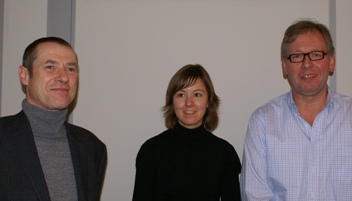Alpharma introduces coccidiosis rotation programme

At a press conference yesterday in Belgium, Maja Mariën of Alpharma Animal Health explained the new approach of fighting coccidiosis in poultry. The main message: rotate the use of different coccidiostats!
| Left to right: Chris Cassan, Country Manager Benelux, Maja Mariën, Technical Manager Poultry Europe, Middle East and Africa, and Karl De Bruyne, Director Sales and Marketing EMEA and Southeast Asia. |
Coccidiosis is a parasitic disease of the intestinal tract caused by microscopic organisms (oocysts) called coccidia. The disease spreads from one animal to another by contact with infected faeces. It is most severe in young or weak animals and often causes bloody diarrhoea.
Eimeria
“The coccidia damage the gut wall, and this type of damage is invisible to the human eye,” explained Maja Mariën DVM, Technical Manager Poultry at Alpharma. The bloody diarrhoea is always a clear sign that we deal with coccidiosis, but not all types of Eimeria cause bloody spots in the faeces (only the Eimeria tenella). But the other ones E. acervulina, E. maxima, E. mitis and E. praecox are just as important, explains Mariën. They all mitigate the gut wall at different points and therefore cause different clinical signs.
Economic impact
“The economic damage of the disease is gigantic” explained Mariën. According to recent estimations of the world production of birds (2.2 kg birds), the economic damage of coccidiosis is US$2.5-3 bln per year. This is €0.5 per chicken. For a farm with 20,000 broilers, this means a damage of €1,000 per round. A UK study calculated that the disease costs the UK poultry industry £38.6 mln, of which 46% is caused by reduced growth and 34% through a worst feed conversion rate. “It is therefore not so much the dead chickens that need to be removed from the flock that are the most costly for a farmer; the reduced growth has a much larger economic impact”.
Control measures
There are several measures to control coccidiosis: vaccination, in feed medication of coccidiostats and proper cleaning. Often these three measures are used together.
A coccidiostat of a certain group (chemical or ionophore) or family (monovalent, divalent or monovalent glycoside) are always used as a preventive method. “Resistance is a problem, explained Marien. Consecutive use of the same product results in resistant coccidiën that in turn results in more problems in the birds (higher feed conversion, slower growth and increase contamination). It also increases the risk of a clinical coccidiosis outbreak.
Rotation
Alpharma has been testing coccidiosis measures for many years and these experiences have now led to the introduction of the rotation programme. The principles are very simple: change the coccidiostat group and / or family at certain times. It is important that certain products are not used after each other. After use of an ionophore, it is recommended not to use an ionophore of the same family for the consecutive three rounds. The use of a chemical coccidiostat should be limited to once a year. An example of a simplified rotation programme (using only ionophores) could look like this:
An example of a more complicated rotation programme could look like this:
Conclusions
Maja Mariën conlcuded her presentation saying that subclinical coccodiosis should not be underestimated. She addressed the importance of cocciodiostats in animal feed. Rotation of coccidiostats is very important to prevent resistance of the oocysts. Certain ionohores sdhould therefore not be used after each other and chemical coccidiostats should be limited to use once a year.
Alpharma was created in 1994. Now part of King Pharmaceuticals, Alpharma Animal Health is the number 10 animal health company in the world.













